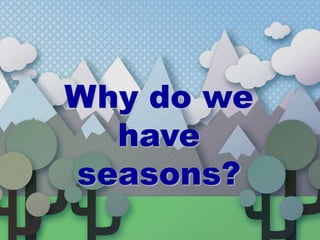
Seasons.ppt
- 2. Earth’s rotation • The Earth rotates on its axis (imaginary vertical line around which Earth spins) every 23 hours & 56 minutes. • One day on Earth is one rotation of the Earth. • One Day on Earth is when our side of the Earth faces the sun. • Night on Earth is when the side of Earth we are on faces away from the sun.
- 3. Earth’s revolution • It takes the Earth 365.25 days (or rotations) to travel or revolve around the Sun once. • This is called a year. Orbit
- 4. Motion Terminology • Rotation – to spin on an axis
- 5. Motion Terminology • Revolution – the motion of a body around another body
- 6. Motion Terminology • Orbit – the path that is followed around another body in space
- 7. Why do we have seasons? • The Earth’s orbit around the sun is NOT a perfect circle. It is an ellipse. • Seasons are not caused by how close the Earth is to the sun. • In fact, the Earth is closest to the sun around January 3 and farthest away from the sun around July 4. Ellipse
- 8. Why do we have seasons? • Seasons are the result of the tilt of the Earth's axis. • Earth’s axis is tilted 23.5°. • This tilting is why we have SEASONS like fall, winter, spring, summer. • The number of daylight hours is greater for the hemisphere, or half of Earth, that is tilted toward the Sun. • Seasons Interactive
- 9. Why do we have seasons? • Summer is warmer than winter (in each hemisphere) because the Sun's rays hit the Earth at a more direct angle during summer than during winter
- 10. Why do we have seasons? • Also the days are much longer than the nights during the summer. • During the winter, the Sun's rays hit the Earth at an extreme angle, and the days are very short. These effects are due to the tilt of the Earth's axis.
- 11. Seasons…in a nut shell
- 12. Solstices • Occur twice a year, when the tilt of the Earth's axis is oriented at its extremes. Tilted the farthest or closest • Winter solstice is the shortest day of the year. In the Northern Hemisphere. It occurs on December 21 or 22 and marks the beginning of winter. • The Summer Solstice is the longest day of the year. It occurs on June 20 or 21 and marks the beginning of summer.
- 14. Equinoxes • A day lasts 12 hours and a night lasts 12 hours at all latitudes. • Equinox literally means "equal night". • Sunlight strikes the earth most directly at the equator. • This occurs twice a year.
- 15. Equinox • The vernal (spring) equinox occurs March 20. • The autumnal (fall) equinox occurs September 22 or 23.
- 16. The Earth's seasons are not caused by the differences in the distance from the Sun throughout the year.
- 17. Review Look closely at where the Sun is hitting the Earth during each season: